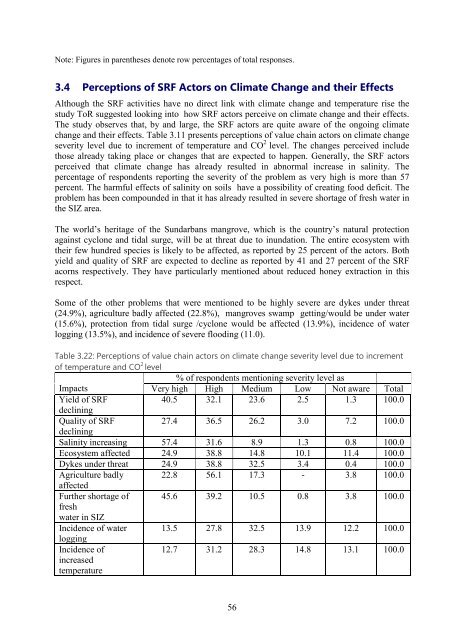INTEGRATED PROTECTED AREA CO-MANAGEMENT (IPAC) - BIDS
INTEGRATED PROTECTED AREA CO-MANAGEMENT (IPAC) - BIDS
INTEGRATED PROTECTED AREA CO-MANAGEMENT (IPAC) - BIDS
You also want an ePaper? Increase the reach of your titles
YUMPU automatically turns print PDFs into web optimized ePapers that Google loves.
Note: Figures in parentheses denote row percentages of total responses.<br />
3.4 Perceptions of SRF Actors on Climate Change and their Effects<br />
Although the SRF activities have no direct link with climate change and temperature rise the<br />
study ToR suggested looking into how SRF actors perceive on climate change and their effects.<br />
The study observes that, by and large, the SRF actors are quite aware of the ongoing climate<br />
change and their effects. Table 3.11 presents perceptions of value chain actors on climate change<br />
severity level due to increment of temperature and <strong>CO</strong> 2 level. The changes perceived include<br />
those already taking place or changes that are expected to happen. Generally, the SRF actors<br />
perceived that climate change has already resulted in abnormal increase in salinity. The<br />
percentage of respondents reporting the severity of the problem as very high is more than 57<br />
percent. The harmful effects of salinity on soils have a possibility of creating food deficit. The<br />
problem has been compounded in that it has already resulted in severe shortage of fresh water in<br />
the SIZ area.<br />
The world’s heritage of the Sundarbans mangrove, which is the country’s natural protection<br />
against cyclone and tidal surge, will be at threat due to inundation. The entire ecosystem with<br />
their few hundred species is likely to be affected, as reported by 25 percent of the actors. Both<br />
yield and quality of SRF are expected to decline as reported by 41 and 27 percent of the SRF<br />
acorns respectively. They have particularly mentioned about reduced honey extraction in this<br />
respect.<br />
Some of the other problems that were mentioned to be highly severe are dykes under threat<br />
(24.9%), agriculture badly affected (22.8%), mangroves swamp getting/would be under water<br />
(15.6%), protection from tidal surge /cyclone would be affected (13.9%), incidence of water<br />
logging (13.5%), and incidence of severe flooding (11.0).<br />
Table 3.22: Perceptions of value chain actors on climate change severity level due to increment<br />
of temperature and <strong>CO</strong> 2 level<br />
% of respondents mentioning severity level as<br />
Impacts Very high High Medium Low Not aware Total<br />
Yield of SRF<br />
40.5 32.1 23.6 2.5 1.3 100.0<br />
declining<br />
Quality of SRF<br />
27.4 36.5 26.2 3.0 7.2 100.0<br />
declining<br />
Salinity increasing 57.4 31.6 8.9 1.3 0.8 100.0<br />
Ecosystem affected 24.9 38.8 14.8 10.1 11.4 100.0<br />
Dykes under threat 24.9 38.8 32.5 3.4 0.4 100.0<br />
Agriculture badly 22.8 56.1 17.3 - 3.8 100.0<br />
affected<br />
Further shortage of 45.6 39.2 10.5 0.8 3.8 100.0<br />
fresh<br />
water in SIZ<br />
Incidence of water 13.5 27.8 32.5 13.9 12.2 100.0<br />
logging<br />
Incidence of<br />
increased<br />
temperature<br />
12.7 31.2 28.3 14.8 13.1 100.0<br />
56














